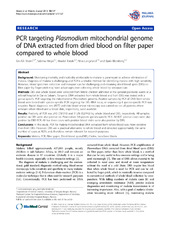| dc.contributor.author | Strøm, Gro Elizabeth Ann | en_US |
| dc.contributor.author | Moyo, Sabrina John | en_US |
| dc.contributor.author | Fataki, Maulidi | en_US |
| dc.contributor.author | Langeland, Nina | en_US |
| dc.contributor.author | Blomberg, Bjørn | en_US |
| dc.date.accessioned | 2014-05-14T09:39:39Z | |
| dc.date.available | 2014-05-14T09:39:39Z | |
| dc.date.issued | 2014-04-07 | eng |
| dc.identifier.issn | 1475-2875 | |
| dc.identifier.uri | https://hdl.handle.net/1956/7928 | |
| dc.description.abstract | Background: Monitoring mortality and morbidity attributable to malaria is paramount to achieve elimination of malaria. Diagnosis of malaria is challenging and PCR is a reliable method for identifying malaria with high sensitivity. However, blood specimen collection and transport can be challenging and obtaining dried blood spots (DBS) on filter paper by finger-prick may have advantages over collecting whole blood by venepuncture. Methods: DBS and whole blood were collected from febrile children admitted at the general paediatric wards at a referral hospital in Dar es Salaam, Tanzania. DNA extracted from whole blood and from DBS was tested with a genus-specific PCR targeting the mitochondrial Plasmodium genome. Positive samples by PCR of DNA from whole blood were tested with species-specific PCR targeting the 18S rRNA locus, or sequencing if species-specific PCR was negative. Rapid diagnostic test (RDT) and thin blood smear microscopy was carried out on all patients where remnant whole blood and a blood slide, respectively, were available. Results: Positivity of PCR was 24.5 (78/319) and 11.2% (52/442) by whole blood and DBS, respectively. All samples positive on DBS were also positive on Plasmodium falciparum species-specific PCR. All RDT positive cases were also positive by DBS PCR. All but three cases with positive blood slides were also positive by DBS. Conclusions: In this study, PCR for malaria mitochondrial DNA extracted from whole blood was more sensitive than from DBS. However, DBS are a practical alternative to whole blood and detected approximately the same number of cases as RDTs and, therefore, remain relevant for research purposes. | en_US |
| dc.language.iso | eng | eng |
| dc.publisher | BioMed Central | eng |
| dc.relation.ispartof | <a href="http://hdl.handle.net/1956/7929" target="blank">Diagnosing pediatric malaria in Dar es Salaam, Tanzania. Clinical and laboratorial perspectives</a> | eng |
| dc.rights | Attribution CC BY | eng |
| dc.rights.uri | http://creativecommons.org/licenses/by/2.0/ | eng |
| dc.subject | Malaria | eng |
| dc.subject | PCR | eng |
| dc.subject | Filter paper | eng |
| dc.subject | Dried blood spots/DBS | eng |
| dc.subject | Chelex | eng |
| dc.subject | InstaGene Matrix | eng |
| dc.title | PCR targeting Plasmodium mitochondrial genome of DNA extracted from dried blood on filter paper compared to whole blood | en_US |
| dc.type | Peer reviewed | |
| dc.type | Journal article | |
| dc.date.updated | 2014-04-11T11:18:43Z | |
| dc.description.version | publishedVersion | en_US |
| dc.rights.holder | Copyright 2014 Strøm et al.; licensee BioMed Central Ltd. | |
| dc.rights.holder | Gro EA Strøm et al.; licensee BioMed Central Ltd. | |
| dc.source.articlenumber | 137 | |
| dc.identifier.doi | https://doi.org/10.1186/1475-2875-13-137 | |
| dc.identifier.cristin | 1161706 | |
| dc.source.journal | Malaria Journal | |
| dc.source.40 | 13 | |

